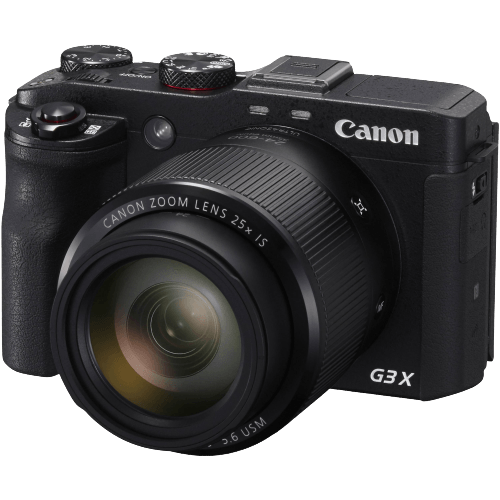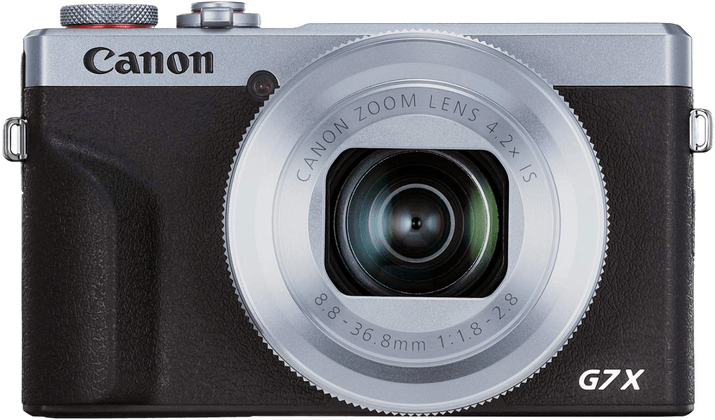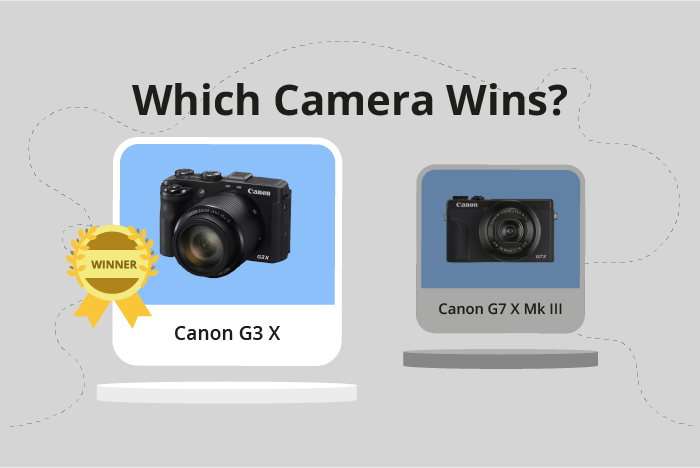Canon PowerShot G3 X vs PowerShot G7 X Mark III Comparison
Canon PowerShot G3 X

Canon PowerShot G7 X Mark III

The Canon PowerShot G3 X outperforms the Canon PowerShot G7 X Mark III by a small margin, scoring 62/100 compared to the G7 X Mark III’s 59/100. Both cameras share similarities such as being released by Canon and having similar announcement dates, with the G3 X in 2015 and the G7 X Mark III in 2019.
The G3 X, a bridge camera, offers a larger size (123 x 77 x 105mm) and weight (733g / 1.62lbs), providing more stability for users. It was launched at a price of $999, reflecting its superior performance. On the other hand, the G7 X Mark III, a compact camera, is smaller (105 x 61 x 41mm) and lighter (304g / 0.67lbs), making it more portable and convenient for on-the-go photography. Its launch price was $749, making it a more affordable option for budget-conscious consumers.
Considering these factors, the Canon PowerShot G3 X stands out as a better choice for those who prioritize performance and stability, while the Canon PowerShot G7 X Mark III caters to those who seek portability and affordability.
Canon PowerShot G3 X vs PowerShot G7 X Mark III Overview and Optics
The Canon PowerShot G3 X and Canon PowerShot G7 X Mark III both have a score of 57/100 for their optics, indicating no clear winner between the two.
Both cameras share some common specifications, such as having 20 megapixels, a CMOS sensor, 1″ sensor size, and image stabilization. Additionally, neither camera has a lens mount, as they both use fixed lens mounts. This means that you cannot change the lens on either camera.
The G7 X Mark III has a superior shooting speed of 30 compared to the G3 X’s 5.9, which makes it a better choice for capturing fast-moving subjects or taking continuous shots. The G7 X Mark III also has a more advanced processor, the Digic 8, which allows for faster image processing and better overall performance. However, its DXOMARK score for the sensor is slightly lower at 58, compared to the G3 X’s 63.
On the other hand, the G3 X’s higher DXOMARK score indicates that its sensor has better overall quality, which could result in improved image quality. However, this advantage is somewhat offset by the G3 X’s slower shooting speed and older Digic 6 processor.
When comparing the optics of the Canon PowerShot G3 X and Canon PowerShot G7 X Mark III, the choice ultimately comes down to personal preference and intended use. If faster shooting speed and a more advanced processor are important factors, the G7 X Mark III would be the better choice. However, if image quality is the primary concern, the G3 X’s higher DXOMARK score may sway your decision.
Canon PowerShot G3 X vs PowerShot G7 X Mark III Video Performance
The Canon PowerShot G7 X Mark III outperforms the Canon PowerShot G3 X in terms of video capabilities, scoring 91/100 compared to the G3 X’s score of 70/100. Both cameras share some common features, such as time-lapse functionality built-in, which allows users to create stunning time-lapse videos with ease.
The G7 X Mark III excels with its higher maximum video resolution of 4K (3840 x 2160), compared to the G3 X’s Full HD (1920 x 1080) resolution. This significant difference in resolution enables the G7 X Mark III to capture more detailed and sharper videos, offering a superior visual experience for viewers. Additionally, the G7 X Mark III boasts a higher maximum video frame rate of 120fps, as opposed to the G3 X’s 60fps. This higher frame rate allows for smoother slow-motion video capture and improved overall video quality.
Despite its lower score, the G3 X still has some advantages in its video capabilities. It offers Full HD video resolution, which is sufficient for casual users and those not requiring the highest video quality. Additionally, its 60fps frame rate is adequate for most everyday video capture needs.
When comparing the video capabilities of both cameras, it is clear that the Canon PowerShot G7 X Mark III is the superior choice for those seeking higher video quality and resolution. Its 4K resolution and 120fps frame rate offer significant improvements over the G3 X’s Full HD resolution and 60fps frame rate. However, the Canon PowerShot G3 X remains a viable option for users who prioritize other features and do not require the highest video quality.
Canon PowerShot G3 X vs PowerShot G7 X Mark III Features and Benefits
The Canon PowerShot G3 X outperforms the Canon PowerShot G7 X Mark III in features, scoring 87/100 compared to the G7 X Mark III’s 70/100. Both cameras share several common specifications, including touchscreen capability, flip screens, GPS absence, WiFi, and Bluetooth connectivity.
The G3 X shows superiority in its larger screen size and higher screen resolution. It has a 3.2-inch screen, while the G7 X Mark III has a slightly smaller 3-inch screen. The G3 X also boasts a higher screen resolution of 1,620,000 dots, compared to the G7 X Mark III’s 1,040,000 dots. This means that the G3 X provides users with a larger and clearer display for composing shots and reviewing images.
On the other hand, the G7 X Mark III has its advantages. However, they are not significant enough to outweigh the benefits provided by the G3 X’s superior features. The G7 X Mark III is still a good camera, but it falls short when compared to the G3 X.
Considering the differences in features, the Canon PowerShot G3 X emerges as the clear winner. Its larger screen size and higher screen resolution offer users a better experience when capturing and reviewing images. The G7 X Mark III, while still a capable camera, lacks the extra edge provided by the G3 X’s superior features. Buyers looking for a camera with better features should opt for the Canon PowerShot G3 X.
Canon PowerShot G3 X vs PowerShot G7 X Mark III Storage and Battery
The Canon PowerShot G7 X Mark III outperforms the Canon PowerShot G3 X in storage and battery, scoring 27 out of 100 compared to the G3 X’s 16. Both cameras have a single memory card slot and accept SD, SDHC, and SDXC (UHS-I compatible) cards.
The G7 X Mark III has the advantage of USB charging, a convenient feature that the G3 X lacks. This makes it easier to charge on-the-go without needing to carry a separate charger. However, the G3 X has a longer battery life with 300 shots, while the G7 X Mark III only provides 235 shots. The G3 X utilizes the NB-10L battery type, whereas the G7 X Mark III uses the NB-13L battery type.
Despite the G3 X’s longer battery life, the G7 X Mark III’s USB charging capability and overall higher score make it the better choice in terms of storage and battery.
Canon PowerShot G3 X vs PowerShot G7 X Mark III – Our Verdict
Are you still undecided about which camera is right for you? Have a look at these popular comparisons that feature the Canon PowerShot G3 X or the Canon PowerShot G7 X Mark III:
- Canon PowerShot G7 X Mark III vs Sony Cyber-shot DSC-RX100 VII
- Canon PowerShot G7 X Mark II vs PowerShot G7 X Mark III
- Canon PowerShot G5 X Mark II vs PowerShot G7 X Mark III
- Canon PowerShot G7 X Mark III vs Panasonic Lumix ZS200 (TZ200)
- Canon PowerShot G7 X Mark III vs Ricoh GR IIIx
- Canon PowerShot G7 X Mark III vs Sony ZV-E10

